Remote Setting (Part 2)
John W. McCabe
Remote Setting Tanks (C. gigas)
Some type of open, large vat or pool, hereafter called a tank,
is essential in remote setting. Remote setting tanks, simply
called setting tanks by growers, come in various sizes,
shapes and designs. Numerous materials have been used in their
construction. Fiberglass, stainless steel and concrete tanks
are the most common. Whatever the material used in tank construction,
it is imperative that it does not emit toxins when remote setting
is attempted. The same applies to any accessories (e.g. PVC aeration
pipes, hoses) that come in contact with the water in the setting
tanks. Hidden toxin sources are certain sealants that retain
"superior flexibility" and, worse yet, are "mildew
resistant". Instead, any sealant in contact with the water
of such a cultivation environment should be "aquarium safe".
It is common knowledge in the shellfish industry that even minute
toxin amounts can negatively affect larval setting. As such,
newly constructed fiberglass and concrete tanks and accessories
must first thoroughly "cure" before use. In some cases,
this can take several months. Some stainless alloys can also
be problematic.
Ironically, as annoying as later scrubbing countless renegade
spat off the sidewalls of a setting tank is, it is an endorsement
of its functionality.
Most setting tanks are operated outside. Some tanks are insulated.
While there is no such thing as a "standard
setting tank", they all have features in common. An oyster
grower that employs remote setting will typically own one or
more setting tanks that work well with the cultivation method
he or she employs (e.g. ground/bottom cultivation, longline cultivation).
It must hold a sufficient amount of weathered oyster shells (cultch)
in a way that is conducive for larvae to distribute and affix
themselves as evenly in quantity as possible to the individual
shells provided.
The saltwater in setting tanks usually originates from a marine
environment close-by, typically the grower's leased or owned
tideland. To aid the distribution of larvae, the water in the
setting tanks is agitated, often by bubbling with oil-less compressed
air through perforated PVC pipes. In most cases, the water is
heated and maintained at about 20 to 25° C (68 to 77°
F). Seawater in setting tanks can be heated in numerous ways
(e.g. electric, oil, propane, natural gas heaters or passive
solar heating). All setting tanks must be thoroughly cleaned
after use. This includes scrubbing off spat that has glued itself
to side-walls instead of the offered cultch. Some growers use
stainless steel wool to aid in tank-cleanup.
Depending on the size and number of tanks
and methodology employed, the remote setting process can last
about one to two weeks (excluding any additional marine preconditioning
of cleaned cultch). Cleaning of the setting tanks and accessories
before and after is essential. Some growers add microalgae to
their tanks before, during, and/or after the setting. How much
remote setting a grower engages in is usually based on that grower's
projected oyster production in coming years. It need not be done
all at once. In the course several months, the same tanks may
be used repeatedly to produce more spatted cultch. In the North-American
Pacific Northwest, remote setting commonly starts in early spring
and, in some cases, may continue at intervals until early summer.
Cultch
The word cultch (also
culch) describes a wide variety of objects, naturally
occurring or manmade, that are utilized for their appeal to larval
or post-larval bivalves as attachment and early grow-out surfaces.
In some cases, the alternate term spat collector(s) is
preferred. In oyster cultivation, weathered oyster shells are
traditionally the preferred type of cultch.
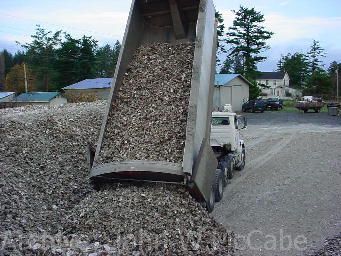 Inset
image: Large transporter dumping oyster shells from shucking
facilities for natural weathering.
Inset
image: Large transporter dumping oyster shells from shucking
facilities for natural weathering.
Oyster growers have long known that oyster
larvae love to cement themselves to oyster shells. Many oyster
growers on the North-American West Coast and in Asia process
Pacific/Japanese oysters for their meat only (called shucking),
meaning that these oyster are not destined for the half-shell
market (i.e. where oysters are slurped raw off the half-shell).
Once the meat is extracted, the growers save the shells. Oyster
growers then allow them to weather in huge piles on land for
later use. These mounds of fresh shells from a shucking facility
are of great interest to birds, bugs and bacteria. They immediately
start stripping every last bit of oyster meat left on the shells.
The sun and wind gradually desiccate the shells. The freshwater
from rain gently erodes the calcium carbonate. The organic matrix
of the shells also gradually dries, thus reducing structural
impact resilience. About two years later, the oyster shells are
lighter and have structurally weakened. At this point, they can
be considered cultch. Lighter shell weight presents a
little advantage in their transport. More importantly, however,
years later, when spat on these shells has grown and turned each
one into a massive clusters of live oysters, the somewhat weakened
old shells help in the process of breaking the oyster clusters
apart (called culling).
Before usage, the cultch is often fed through
a trommel (from the German word Trommel, meaning
drum). The trommel separates debris (small shell fragments, soil,
leaves etc) from the shells. The shells are then typically washed
with 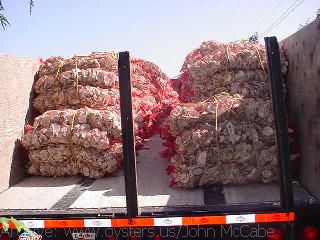 pressurized water and packed into
synthetic mesh bags or other, similarly webbed containers.
pressurized water and packed into
synthetic mesh bags or other, similarly webbed containers.
Inset image: A 40 ft (~ 12 m) commercial flatbed trailer loaded
with a shipment of clean cultch, parked at the Coast Seafoods
hatchery in Quilcene, Washington State. Clean cultch is commonly
packed in polyethylene mesh sacks (e.g. Vexar) which can be stacked
like 4 ft logs for transport. Click image for a closer look.
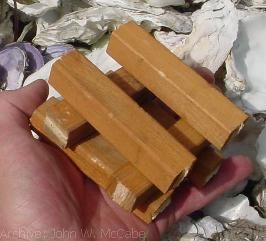 Inset image: Example of a crisscross
stack. In remote setting, polyethylene mesh sacks can effectively
be stacked in a crisscross fashion, akin to the way logs can
be stacked when building a campfire. Stacking cultch in this
manner allows good water circulation and optimizes shell surface
exposure for the attachment of oyster larvae.
Inset image: Example of a crisscross
stack. In remote setting, polyethylene mesh sacks can effectively
be stacked in a crisscross fashion, akin to the way logs can
be stacked when building a campfire. Stacking cultch in this
manner allows good water circulation and optimizes shell surface
exposure for the attachment of oyster larvae.
In preparation for remote setting, some growers further condition
the clean cultch by temporary submersion in bay water. Doing
so will thinly coat the shells with so called biofilm,
a rather nondescript word that describes a slippery, organic
coating that usually includes bacteria. It is believed that a
measured amount of biofilm can be attractive to oyster larvae
that are ready to attach themselves and may possibly be of nutritional
significance. Other growers do not further condition their cultch
in this manner. Instead, the clean cultch is directly offered
to the larvae. Although both methods can work well, neither guarantees
a "good set" because various other factors come into
play (e.g. water circulation, temperature, water quality, larval
condition). It is to be expected as normal that many of the oyster
larvae will die before ever attaching themselves to the shells.
Many more will die during metamorphosis and still more will die
soon thereafter. In practice this means that only a small fraction
of the larvae in the aforementioned pouches will reach a marketable
oyster size.
Once the shells are populated with spat, they are called spatted
cultch.
Set and Spatcount
The noun set describes
visible evidence on marine surfaces, especially cultch, of an
aggregation of oysters or other bivalves that have very recently
completed metamorphosis.
Oyster growers rate sets (e.g. very good, good, light, poor or
no set) on the basis of the average spat population found on
surfaces in a given area, typically the surfaces of oyster shells
(i.e. the spat found on a flat or cupped valve). For example,
after remote setting, averaging the numbers of spat found on
50 to 100 shells sampled from various areas of a setting tank
will yield the spatcount.
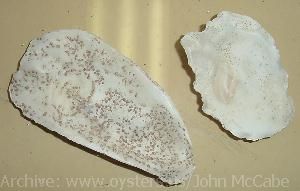 Inset image:
The shell portion on the left (approx. 10 cm or 4")
shows early post-larval Pacific oysters at about three weeks
from setting. In remote setting, the set on this shell is excessive
(so called spray paint). As these oysters grow, they will
compete for space while continuously building their shell. Many
will have stunted or malformed shells. Most will not survive.
Click image for enlargement.
Inset image:
The shell portion on the left (approx. 10 cm or 4")
shows early post-larval Pacific oysters at about three weeks
from setting. In remote setting, the set on this shell is excessive
(so called spray paint). As these oysters grow, they will
compete for space while continuously building their shell. Many
will have stunted or malformed shells. Most will not survive.
Click image for enlargement.
In remote setting of oysters, a "very
good set" typically describes an average of 15 to 30 firmly
cemented post-larval oysters (i.e. the spatcount) that
are distributed fairly evenly per oyster shell. Some growers
and hatcheries prefer 20 to 40. A shell with just six to ten
spat, evenly distributed, is a "light set" that can
ultimately still yield a very nice return after the oysters have
grown. A "poor set" in remote setting are shells that
average less than five spat per shell. Although it seems reasonable
to conclude that hundreds of spat per shell would be cause for
celebration in remote setting, many oyster growers would instead
be quite displeased. Hundreds of spat per shell is called called
spray paint. Crowded spat on shells leads to mass mortality
and tangled, dense clusters of oysters of varying size, many
with malformed shells. When faced with such abundant sets, some
growers have tediously broken the spatted shells into smaller
pieces to later give the growing oysters more room to develop
their shells more freely.
Assessments of sets in remote setting differ
from assessments in "wild sets". The aforementioned
"spray paint" can actually be welcome among bottom
cultivating growers that depend on bountiful wild sets on the
cultch they have tediously spread on their cultivation grounds.
In North-America, the Pacific (or Japanese) oyster used to be
principally valued as a cooking oyster, not as a raw, half-shell
oyster. As such, it was the meat that mattered, not the shape
of the shell. Big, gnarly clusters of oddly shaped, fat oysters
thus spelled profit. This has changed in recent decades. Although
Pacific oysters are still in demand as meat oysters, they are
now also prized as half-shell oysters. In the lucrative half-shell
trade, the shell size and shape matters greatly.
"No set" indicates that all the
money, time and work invested in offering cultch to wild larvae
was for naught. Even if a few wild spat turn up (which is commonly
the case), it is still deemed "no set", because so
few spat are not nearly enough to support a grower's business.
The daunting uncertainty associated with wild sets has plagued
oyster growers worldwide for many centuries. It is the underlying
reason for today's existence of remote setting.
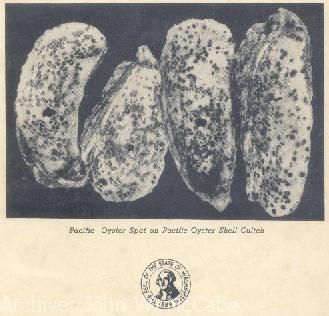 Inset
image: Photo of heavily spatted shells on the cover of the State
of Washington Dept. of Fisheries Biological Report No. 43A, 1943.
This rare report furnishes details on Washington State's 1942
spawning and setting of the Japanese oyster, renamed as the "Pacific
oyster" (then still scientifically known as Ostrea gigas).
The image is titled Pacific Oyster Spat on Pacific Oyster
Shell Cultch. Each shell features well over one hundred wild
spat. They were the result of natural oyster spawning events
at an unspecified location in western Washington. The great quantity
of wild spat per shell qualified as a "very good set".
1942 was a special year for the oyster industry on the North
American West Coast. It was the first year in decades that saw
no Japanese oyster seed shipments (spatted cultch) as both Canada
and the United States were at war with Japan. Fortunately, Pacific
oysters successfully spawned at a never before seen rate during
the war years. The absence of Japanese seed supply was thus easily
bridged with greatly improved, local seed production. At the
same time, Japanese-American oyster growers and their families
were sent to internment camps and usually lost their livelihoods.
Inset
image: Photo of heavily spatted shells on the cover of the State
of Washington Dept. of Fisheries Biological Report No. 43A, 1943.
This rare report furnishes details on Washington State's 1942
spawning and setting of the Japanese oyster, renamed as the "Pacific
oyster" (then still scientifically known as Ostrea gigas).
The image is titled Pacific Oyster Spat on Pacific Oyster
Shell Cultch. Each shell features well over one hundred wild
spat. They were the result of natural oyster spawning events
at an unspecified location in western Washington. The great quantity
of wild spat per shell qualified as a "very good set".
1942 was a special year for the oyster industry on the North
American West Coast. It was the first year in decades that saw
no Japanese oyster seed shipments (spatted cultch) as both Canada
and the United States were at war with Japan. Fortunately, Pacific
oysters successfully spawned at a never before seen rate during
the war years. The absence of Japanese seed supply was thus easily
bridged with greatly improved, local seed production. At the
same time, Japanese-American oyster growers and their families
were sent to internment camps and usually lost their livelihoods.
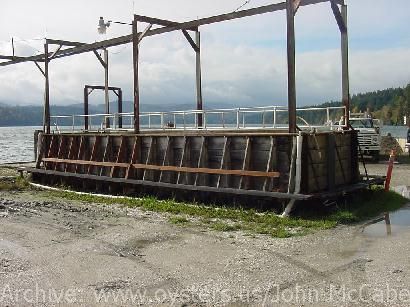 Example of Remote Setting in a Large Setting Tank
Example of Remote Setting in a Large Setting Tank
The inset image shows a fiberglass setting tank, one of three,
located at the Olympia Oyster Company (click image to enlarge).
With a capacity of 28,350 liters (7,500 gallons) it qualifies
as a large setting tank. Larger setting tanks exist. The setting
tanks at this grower's facility are not insulated. The pictured
tank is about 12 years old. Despite repeated, seasonal usage
and year-round outdoor exposure, the tanks appear as sturdy today
as the day they were built. The size, rectangular design and
support framing suggests that any one of these tanks could, if
needed, be moved elsewhere with moderate preparation. Sturdy
planking surrounds each tank. It provides good footing when working
at waist-height anywhere along the upper, inside edge of the
tanks in a standing position. A heavy gauge, steel frame rises
above each tank. On the frame, a strong, steel overhead rail
can be seen, centered and running lengthwise above the tank.
When in use, the rail is extended to two more steel supports
mounted on a heavy timber bulkhead at the edge of the bay. This
rail serves to facilitate mechanical lowering and hoisting of
heavy cultch containers in and out of the tank and, after remote
setting, moving the cultch containers onto a barge at high tide.
All the setting tanks have industrial lighting fixtures for night-time
work. Seawater from the adjacent bay is pumped into the tank(s)
and then warmed by diesel oil boiler heat-pipes.
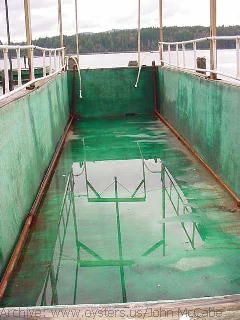 The pictured view
of the inside of the setting tank shows the heat pipes and two
long, white PVC pipe grates resting on the tank's edge. The PVC
pipes are perforated. During remote setting, these grates lie
flat on the bottom of the tank with the cultch on top. During
operation, compressed air from an oil-less electric blower motor
is pumped through the perforated pipes. Subsequent bubbling vigorously
agitates the tank water.
The pictured view
of the inside of the setting tank shows the heat pipes and two
long, white PVC pipe grates resting on the tank's edge. The PVC
pipes are perforated. During remote setting, these grates lie
flat on the bottom of the tank with the cultch on top. During
operation, compressed air from an oil-less electric blower motor
is pumped through the perforated pipes. Subsequent bubbling vigorously
agitates the tank water.
Remote setting at this grower's facility
is repetitive. It may commence sometime in April and continue
until June.
For example, this grower gradually fills the clean setting tanks
with bay water on a Monday and starts warming and agitating the
water with compressed air on Tuesday and Wednesday. Historically,
much like many other oyster growing regions, the Puget Sound
region has also had occasional seawater conditions that proved
detrimental to the setting of oyster larvae and survival of spat
(e.g. blooms of certain algal species, heavy siltation). Some
growers thus filter the seawater they use for remote setting.
This grower does not. Instead, Tim McMillin, a second generation
oysterman and the longtime general manager of the Olympia Oyster
Company, visually inspects the bay's water condition for appropriate
clarity near the setting tanks before pumping the water in. Occasionally,
further inspection with a microscope is necessary. He has worked
this bay since early childhood and knows it intimately - including
its highly variable water conditions.
On Thursday, containers filled with clean cultch are added. Several
small, meshed testing bags with cultch are also added in various
areas of each tank. The clean cultch is not preconditioned in
the bay prior to use (i.e. no light biofilm is provided). On
Friday, remote setting is initiated by adding the larvae to the
warmed, agitated water in the setting tank. No microalgae feed
is added to the water at any point. On the following Monday,
the small, meshed bags with cultch are pulled for examination.
Microscopic inspection of numerous shells provides an approximate
spatcount and also shows the condition of the spat. Ideally,
the shell of each spat should appear flat and well affixed to
the cultch (i.e. the spat's shell should not be angled). On Tuesday,
the spatted cultch in the containers is pulled from the tanks
and moved to an intertidal location. Here, the spat will continue
to grow. Some growers cover their spatted cultch out on their
tideland with tarps to protect it from various environmental
threats (e.g. heat, birds). This grower does not. After each
remote setting session, the tanks are scrubbed clean. Typically,
some spat has stubbornly set on the sidewalls of the tanks and
pipes. It is scrubbed off with stainless steel wool.
The Olympia Oyster Company used to operate five large setting
tanks. When I took some of the above pictures, they operated
three. At the time of this writing, they only operate two large
setting tanks and have disposed of the rest. This is because
the shellfish business changes as time goes on and all shellfish
growers must adjust accordingly. The Olympia Oyster Company used
to continuously shuck a large volume of oysters for meat (both
Pacific oysters and petite Olympia oysters, Ostrea lurida).
Much remote setting was necessary to produce sufficient amounts
of Pacifc oysters for meat processing. In recent years, this
company has greatly reduced its shucking and instead shifted
some of its resources into producing more Pacific oyster shell
stock for resale (sizes extra small to large) and expanding tumbler
cultivation of their very popular boutique oysters called Kobachii
- and all the while still maintaining their classic Olympia oyster
cultivation (no longer shucked because Olympia oysters are in
high demand as half-shell oysters). Due to increasing demand,
the Olympia Oyster Company also expanded its Manila and native
littleneck clam cultivation.
The unusually tasty shellfish this company
consistently produces has not been a well kept secret. It has
been my impression over the course of many years that their wholesale
business is consistently brisk.
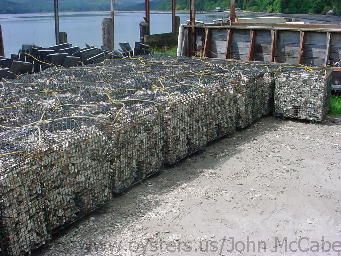 Details on the Cultch Containers
Details on the Cultch Containers
In remote setting, the Olympia
Oyster Company does not use polyethylene mesh sacks filled with
cultch. Instead, they use large, specially designed cultch containers
that are shaped like a cube with meshing on all sides and also
chambered with mesh on the inside (click image to enlarge). This
insures good flow-through of water. Moreover, the design prevents
restrictive compacting of the shells and, a few months later,
allows for easy dumping of the more matured spatted cultch directly
onto tideland. These cultch containers will be moved twice. Firstly,
they are used for the remote setting process by lowering them
into the water filled setting tanks on top of the perforated
PVC pipe grates used for water agitation by aeration. A few days
thereafter, the containers are pulled and placed on a barge to
then be deposited on tideland in a chosen area in the intertidal
zone. A few months later, depending on the rate of further development
of the spat, these containers are moved again to another section
of the company's tideland, typically of lower intertidal elevation,
for further grow-out. The design of the containers allows removal
of sections to prevent the shells from binding-up when spreading
the spatted cultch directly onto the tideland.
Each cultch container is lifted by polyethylene rope secured
on top at all four corners.
 Details on Pitching the Larvae
Details on Pitching the Larvae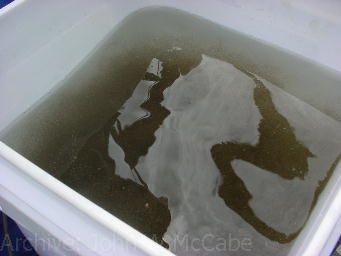
I like to refer to the adding of the oyster larvae to setting
tanks as "pitching the larvae" because it reminds me
of "pitching the yeast" when I make wine and beer.
We now return to the aforementioned "tennis balls"
that each hold six million oyster larvae. The first step is to
open such a pouch full of larvae and inspect its contents. It
should not smell "fishy". The larvae ball can easily
be broken in half. The inside should appear moist, not dried
out. Half of the ball, give or take, is placed into a small bucket
that
is filled about half-way with warmed water from the setting tank.
When gently swishing the larval clump around in the bucket, it
readily dissolves into what looks a bit like clear bouillon soup.
This "larval soup" is then carefully and evenly poured
onto the surface of one half of the setting tank. This procedure
is repeated with the remainder of the larvae in the pouch on
the other half of the setting tank. Just a few days from this
moment, microscopically small specs, the spat, will be evident
on the cultch.
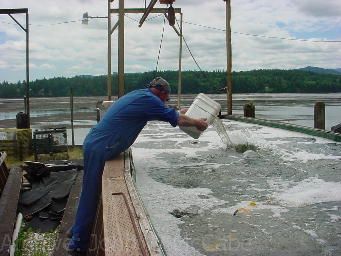
Inset
image: Oyster larvae being evenly "pitched" during
remote setting. Please note the now extended top rail above the
setting tank leading to a heavy timber bulkhead at the edge of
the bay. Please also note the exposed tideland (low tide) beyond
the bulkhead. When the remote setting process is completed, a
barge can conveniently load the cultch containers at the bulkhead
at high tide.
Part
1 Part 2

 William
Firth Wells, Growing Oysters Artificially, The Conservationist,
1920, 3(10), pp 151 -154
William
Firth Wells, Growing Oysters Artificially, The Conservationist,
1920, 3(10), pp 151 -154
 Herbert
F. Prytherch, Experiments in the Artificial Propagation of
Oysters, Dept. of Commerce, Bureau of Fisheries, Doc. No.
961, 1924
Herbert
F. Prytherch, Experiments in the Artificial Propagation of
Oysters, Dept. of Commerce, Bureau of Fisheries, Doc. No.
961, 1924
 Herbert
F. Prytherch, The Cultivation of Lamellibranch Larvae,
found in 1959 reprint by Dover Publications of Culture Methods
for Invertebrate Animals (1937, Comstock Publishing Co.), pp.
539 - 542
Herbert
F. Prytherch, The Cultivation of Lamellibranch Larvae,
found in 1959 reprint by Dover Publications of Culture Methods
for Invertebrate Animals (1937, Comstock Publishing Co.), pp.
539 - 542
 William
K. Brooks, The Oyster, The Johns Hopkins Press, Baltimore,
1891
William
K. Brooks, The Oyster, The Johns Hopkins Press, Baltimore,
1891
 Paul Simon Galtsoff, The
American Oyster Crassostrea Virginica, United States Dept.
of the Interior, Fish and Wildlife Service, Bureau of Commercial
Fisheries, Fishery Bulletin, Volume 64, printed by the United
States Government Printing Office, Washington, 1964
Paul Simon Galtsoff, The
American Oyster Crassostrea Virginica, United States Dept.
of the Interior, Fish and Wildlife Service, Bureau of Commercial
Fisheries, Fishery Bulletin, Volume 64, printed by the United
States Government Printing Office, Washington, 1964
 Victor
L. Loosanoff & Harry C. Davis, Rearing of Bivalve Mollusks,
U.S. Bureau of Commercial Fisheries, 1963
Victor
L. Loosanoff & Harry C. Davis, Rearing of Bivalve Mollusks,
U.S. Bureau of Commercial Fisheries, 1963
 Jerry
E. Clark & R. Donald Langmo, Oyster Seed Hatcheries on
the U.S. West Coast: An Overview, Oregon State University,
Sea Grant College Program, 1979
Jerry
E. Clark & R. Donald Langmo, Oyster Seed Hatcheries on
the U.S. West Coast: An Overview, Oregon State University,
Sea Grant College Program, 1979
 Herbert
Hidu, Samuel R. Chapman and David Dean,
Herbert
Hidu, Samuel R. Chapman and David Dean,
Oyster Mariculture in Subboreal (Maine, United States of America)
Waters: Cultchless Setting and Nursery Culture of European and
American Oysters 1, JOURNAL OF SHELLFISH RESEARCH,
June 1981, Vol. 1, No. 1, pp. 57-67
 https://fisheries.btc.ctc.edu/Manuals/Remote%20Setting%20of%20Oyster%20Larvae.pdf
https://fisheries.btc.ctc.edu/Manuals/Remote%20Setting%20of%20Oyster%20Larvae.pdf
Also found at:
https://www.innovativeaqua.com/Publication/Pub1.htm


